The Red Rectangle Nebula is a protoplanetary nebula located approximately 2,300 light-years away in the constellation Monoceros. It has a radius of 0.14 light-years. The nebula is known for its unusually symmetrical shape, which has puzzled astronomers for decades. It was named the Red Rectangle because of its rectangular shape and red colour.
The Red Rectangle is also known as HD 44179, which is the designation of its central star system. The binary star at the nebula’s core has an apparent magnitude of 9.02 and can be spotted in small telescopes.
The Red Rectangle is an unusual example of a protoplanetary nebula (or preplanetary nebula), a brief phase of evolution of an intermediate-mass star between the late asymptotic branch (AGB) and the planetary nebula phase. The phase lasts a few thousand years at the most.
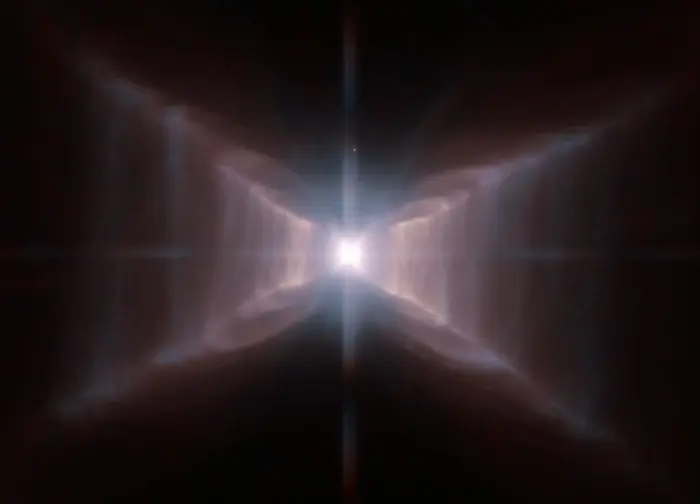
The star HD 44179 is surrounded by an extraordinary structure known as the Red Rectangle. It acquired its moniker because of its shape and its apparent colour when seen in early images from Earth. This strikingly detailed new Hubble image reveals how, when seen from space, the nebula, rather than being rectangular, is shaped like an X with additional complex structures of spaced lines of glowing gas, a little like the rungs of a ladder. The High Resolution Channel of the NASA/ESA Hubble Space Telescope’s Advanced Camera for Surveys captured this view of HD 44179 and the surrounding Red Rectangle nebula — the sharpest view so far. Red light from glowing hydrogen was captured through the F658N filter and coloured red. Orange-red light over a wider range of wavelengths through a F625W filter was coloured blue. Image credit: ESA/Hubble and NASA (PD)
Protoplanetary nebulae form when an intermediate-mass star leaves the tip of the AGB and its extended circumstellar envelope (expelled during the AGB phase) detaches from the stellar photosphere. Once the central star becomes sufficiently hot to photoionise the expelled material, the planetary nebula phase begins.
Other protoplanetary nebulae include the Boomerang Nebula in the constellation Centaurus, the Calabash Nebula in Puppis, the Twin Jet Nebula (Minkowski’s Butterfly) in Ophiuchus, the Frosty Leo Nebula in Leo, the Egg Nebula and the Footprint Nebula (M1-92) in Cygnus, the Water Lily Nebula in Ara, the Cotton Candy Nebula in Scorpius, and the Westbrook Nebula in Auriga.
The Red Rectangle Nebula is a highly symmetrical bipolar nebula with diagonal X-shaped spikes that stand out at red wavelengths. The long spikes and bright bipolar outflow originate deep inside the outflow cavities, and the distinct rungs – spaced lines of glowing gas – indicate several episodes of mass loss at an increased ejection rate.
The origin of the nebula’s axial symmetry is still a mystery. Astronomers have proposed that it may be due to the shocks produced by the interaction of the stellar winds of the two stars at the nebula’s centre.
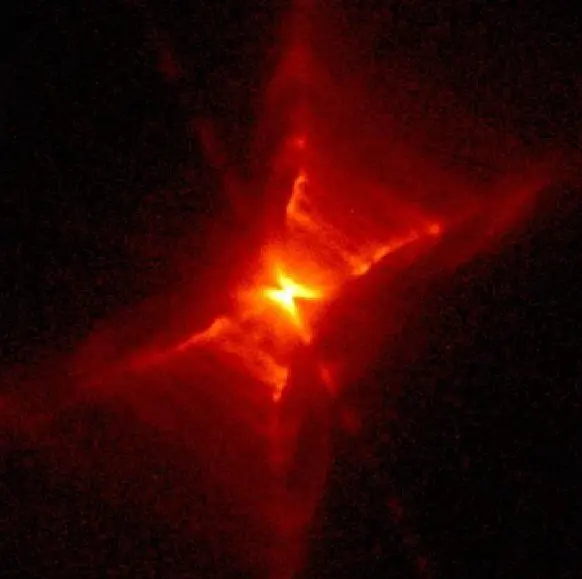
The Red Rectangle Nebula. An excellent example of a bipolar nebula and a protoplanetary/planetary nebula. Image credit: JPL/NASA (PD)
The X-like shape is unusual in a protoplanetary or planetary nebula, as is the low velocity of the outflowing gas. The mechanisms that produced these elements likely have a different origin than those observed in most protoplanetary nebulae.
High-resolution images captured with the Hubble Space Telescope in 1999 revealed the rectangular shape of the nebula to be an optical illusion. The nebula really consists of circular rungs on a pair of lobes that appear X-shaped when seen from the side.
In 1981, a team led by Dutch astronomer Vincent Icke of the Leiden University in the Netherlands demonstrated that cone-like outflows – like those visible in the HST image almost two decades later – could be produced by shocks hitting a dense dusty torus. The shocks were created after a spherical gas ejection from a central star.
The central object of the Red Rectangle is HD 44179, a single-lined spectroscopic binary star composed of a post-AGB primary component and a main sequence companion. The binary system is hidden from view by a thick circumbinary disk. The disk has inner and outer radii of 14 and 43,000 astronomical units, and a thickness of 90 AU.
The compact dusty torus has an estimated mass of 1.2 solar masses. As the particle outflow from the two stars interacts with the disk of dust, it produces the nebula’s recognizable X-shape.
The disk was created as the binary system evolved. As the primary component expanded into a giant, the companion began to accrete its material. This produced the dusty torus. As the main star keeps losing mass, the material is funnelled above and below the torus, producing the double cone.
The mass loss in the primary component is not continuous, but occurs in episodes every few hundred years. These episodic bursts are responsible for creating the nebula’s rung-like structure.
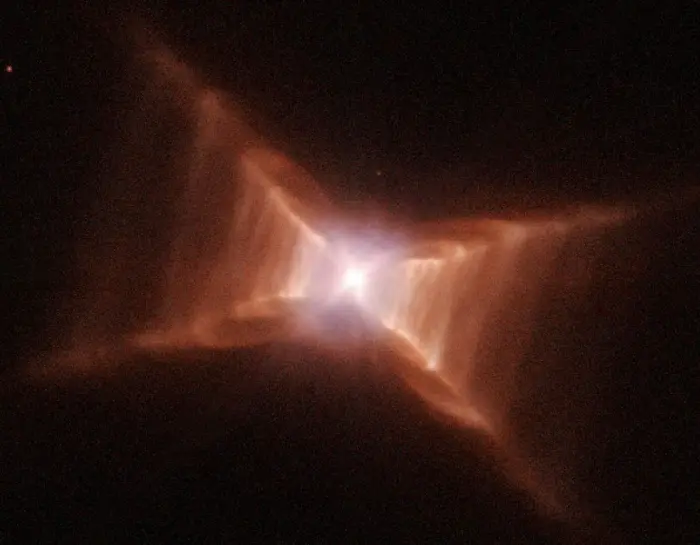
This intriguing image of the intriguing ladder-like structures surrounding a central star reveals startling new details of one of the most unusual nebulae known in our Milky Way. Cataloged as HD 44179, this nebula is more commonly called the “Red Rectangle” because of its unique shape and color as seen with ground-based telescopes. This Hubble Space Telescope image reveals a wealth of new features in the Red Rectangle that cannot be seen with ground-based telescopes looking through the Earth’s turbulent atmosphere. Hubble’s sharp pictures show that the Red Rectangle is not really rectangular, but has an overall X-shaped structure, which arises from outflows of gas and dust from the star in the center. The outflows are ejected from the star in two opposing directions, producing its peculiar shape. Also remarkable are straight features that appear like rungs on a ladder, making the Red Rectangle look similar to a spider web, a shape unlike that of any other known nebula. The star in the center of the Red Rectangle is one that began its life as a star similar to our sun. It is now nearing the end of its lifetime, and is in the process of ejecting its outer layers to produce the visible nebula. Image credit: NASA, ESA, Hans Van Winckel (Catholic University of Leuven, Belgium), and Martin Cohen (University of California, Berkeley) (PD)
The aging primary star started shedding its outer layers about 14,000 years ago as it came to the end of its lifetime. In another few thousand years, it will have become hotter and smaller. As it begins to release brilliant ultraviolet radiation into the surrounding nebula, it will end the protoplanetary stage and produce a planetary nebula.
The primary component of the central star system has a mass of 0.57 solar masses. With an effective temperature of 7,750 K, it is 6,000 times more luminous than the Sun. The stellar parameters were obtained in a study led by A.B. Men’shchikov of the Max Planck Institute for Radio Astronomy in Germany.
The study authors identified the companion as a helium white dwarf with a mass of around 0.35 solar masses and a luminosity of about 100 Suns. Based on their findings, the hot white dwarf star has an estimated surface temperature of 60,000 K and ionizes the bipolar outflow cavities inside the dusty torus, creating a miniature H II region visible at radio wavelengths.
The astronomers proposed that the two components of the close binary system initially had masses of 2.3 and 1.9 solar masses and were at a separation of about 130 solar radii. The nebula was produced when a common envelope was expelled due to Roche lobe overflow of the primary star.
However, a report published in The Astrophysical Journal in 2009 identified the companion as a main sequence star, not a white dwarf, based on an estimated mass 0.94 solar masses. The authors found an orbital period of 318 days for the binary system.
The Red Rectangle Nebula is particularly rich in organic molecules known as polycyclic aromatic hydrocarbons (PAHs). These carbon-bearing macromolecules are mostly found in the X-shaped part of the nebula. The nebula’s equatorial regions contain O-bearing molecules and silicate-rich dust grains.
The polycyclic aromatic hydrocarbons are responsible for the nebula’s red glow. The Extended Red Emission (ERE) in the Red Rectangle was discovered in 1975, but remained a mystery until 2007, when a team of scientists demonstrated that it is produced by unusual clusters of PAHs. These clusters are charged and yet stable enough to survive the harsh interstellar conditions and the intense ultraviolet light that would otherwise destroy them.
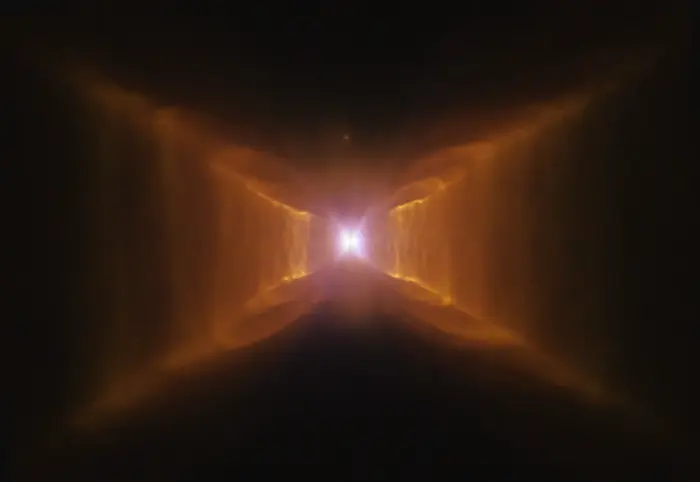
Red Rectangle Nebula, image credit: NASA/ESA (the Hubble Space Telescope); processing: Judy Schmidt (CC BY 2.0)
Facts
The Red Rectangle Nebula was discovered in 1973 during the HI STAR survey, an infrared sky survey conducted by Air Force Cambridge Research Laboratories (AFCRL). The AFCRL survey covered much of the sky with several rocket flights of a small, cryogenically cooled telescope in the early 1970s. The source detections from all the flights were entered into the AFGL (Air Force Geophysics Laboratory) catalogue in 1976 and later into the RAFGL (Revised Air Force Geophysical Laboratory) catalogue in 1983. The Red Rectangle Nebula was catalogued as RAFGL 915.
The name Red Rectangle was given to the nebula by American astronomers Martin Cohen and Mike Merril in 1973 based on the nebula’s appearance on old photographic plates.
The binary system at the core of the Red Rectangle was discovered by American astronomer Robert Grant Aitken in 1915. The double star hunter resolved HD 44179 into two components separated by 0.3 arcseconds. The star system was included in the Aitken Double Star Catalogue (ADS) as ADS 4954 AB. Aitken’s catalogue was published in 1932 under the title New general catalogue of double stars within 120° of the North Pole.
Attempts to observe the binary system in 1948 and 1975 were unsuccessful, either because the separation between the two components was less than 0.1’’ or because one of the stars became obscured by clouds of dust. The components are almost equally bright. They have been observed to vary in brightness by 0 to 0.5 magnitudes, likely because some of their light was absorbed by the surrounding dust.
In 1981, observations with the speckle interferometer of the Imperial College of Science and Technology and the Anglo-Australian telescope yielded a separation of 0.29 ± 0.02 arcseconds between the components.
The Red Rectangle Nebula was the first nebula associated with an evolved star in which an equatorial disk in rotation was identified. Astronomers confirmed the presence of such disks in only a few protoplanetary nebulae and observed only expansion in them, not rotation.
A 2005 study confirmed that the molecular gas in the nebula forms a disk perpendicular to the axis of symmetry and that the disk is in rotation. The disk absorbs the light of the central stars and is virtually invisible in optical images. The study authors presented accurate maps of the gas disk based on observations with the Plateau de Bure interferometer in the French Alps.
In 2013, observations with the Atacama Large Millimeter/submillimeter Array (ALMA) in the Atacama Desert in Chile confirmed that the equatorial disk is in rotation and detected a low-velocity outflow in the region between the disk and the optical X-shaped nebula. The outflow has a velocity of 10 km s-1. The expanding component is denser toward the centre and the temperature of the gas is constant at 200 K.
The Red Rectangle Nebula should not be mistaken for the Red Square Nebula, a square-shaped nebula located in the constellation Serpens. Like the Red Rectangle, the Red Square has a distinctive shape and is one of the most symmetrical celestial objects ever discovered. It lies approximately 5,000 light-years away.
Location
The Red Rectangle Nebula lies in the faint constellation of Monoceros, the Unicorn. The stars of Monoceros are difficult to make out from light-polluted areas. However, most of the constellation lies within the Winter Triangle, a bright, large asterism formed by Betelgeuse in the constellation Orion, Sirius in Canis Major, and Procyon in Canis Minor.
The Red Rectangle can be found using Sirius and the bright stars of Orion. It appears about a quarter of the way from Sirius to Bellatrix, along the imaginary line extended from Rigel through Saiph. It forms a triangle with the faintly visible stars Beta and Gamma Monocerotis. The reflection nebula NGC 2170 (the Angel Nebula) appears in the same region, northwest of the Red Rectangle.
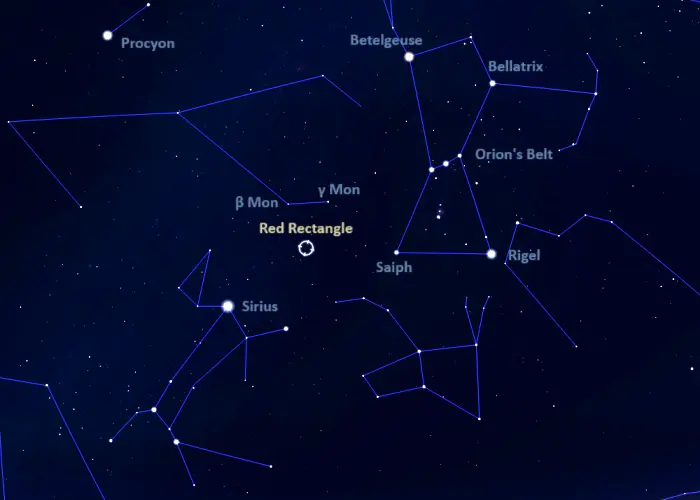
The location of the Red Rectangle Nebula, image: Stellarium
The Red Rectangle is a difficult target for amateur astronomers. The nebulosity is difficult to see because of the brightness of the central binary star. However, the nebula can be spotted in large amateur telescopes and is best seen with filters.
The best time of the year to observe the Red Rectangle and other deep sky objects in Monoceros is during the month of February, when the constellation is higher above the horizon in the early evening. At declination -10° 38’, the nebula is visible from virtually any inhabited place on Earth for at least part of the year.
Red Rectangle Nebula
| Constellation | Monoceros |
| Object type | Protoplanetary nebula |
| Right ascension | 06h 19m 58.2185496s |
| Declination | −10° 38′ 14.706068″ |
| Apparent magnitude | 9.02 |
| Radius | 0.14 light-years |
| Distance | 2.3 ± 0.3 kilolight-years (710 ± 100 parsecs) |
| Names and designations | Red Rectangle Nebula, HD 44179, HIP 30089, SAO 151362, RAFGL 915, ADS 4954 AB, BD-10 1476, ALS 19755, CCDM J06200-1038AB, GSC 05367-01134, GSC2 S1003213403, PPM 217028, NSV 2919, IDS 06153-1036 AB, IRAS 06176-1036, 2MASS J06195821-1038146, PN G218.9-11.7, WDS J06200-1038AB, TYC 5367-1134-1, Gaia DR2 3001477146793228288 |